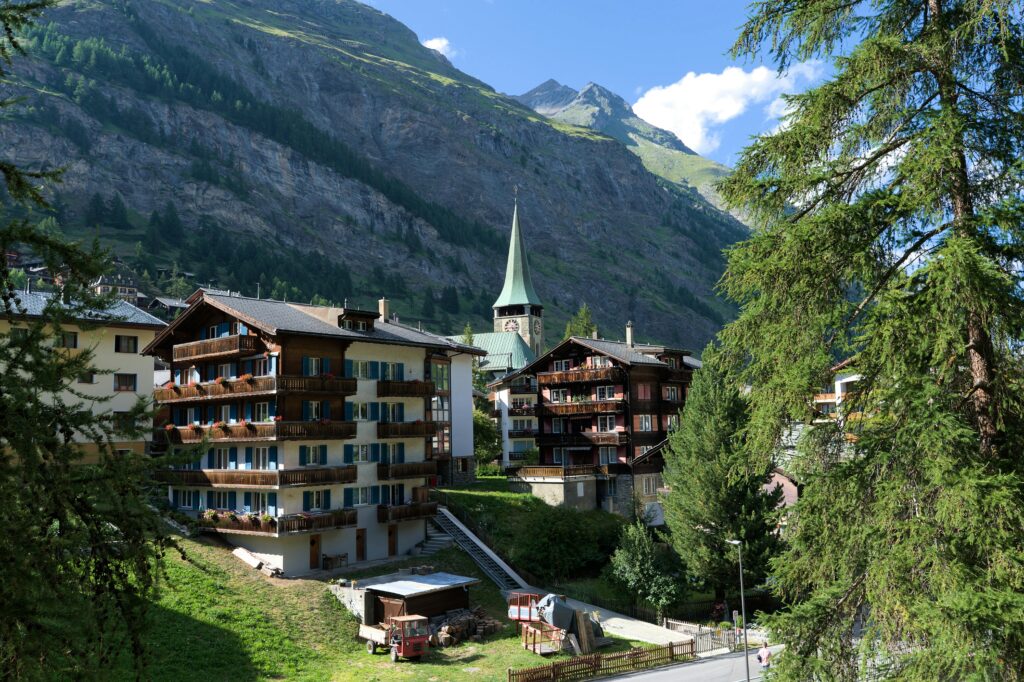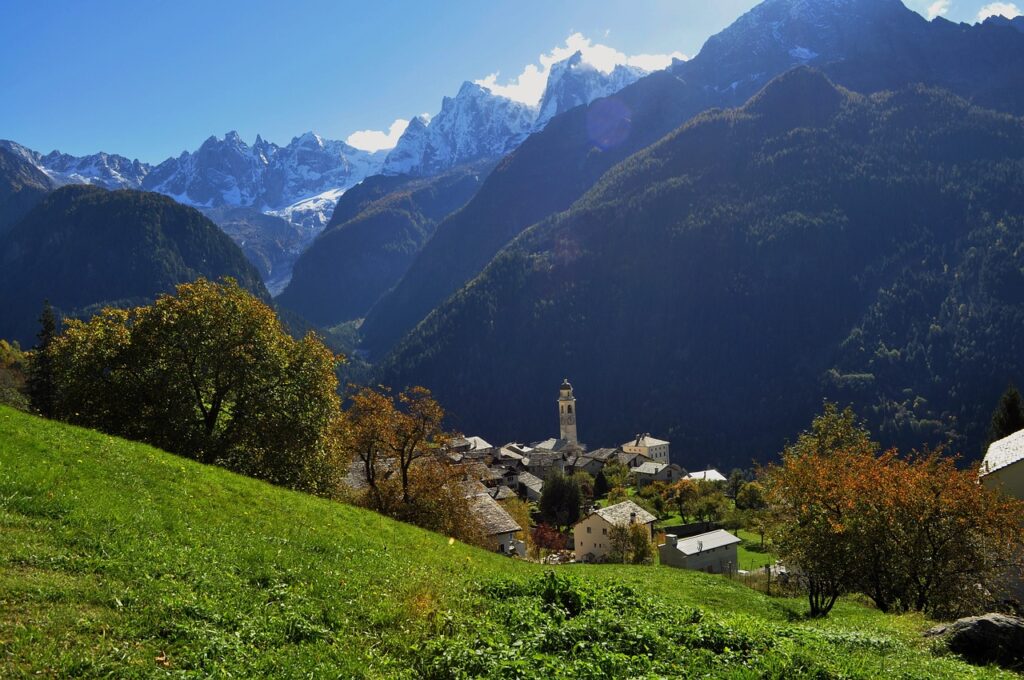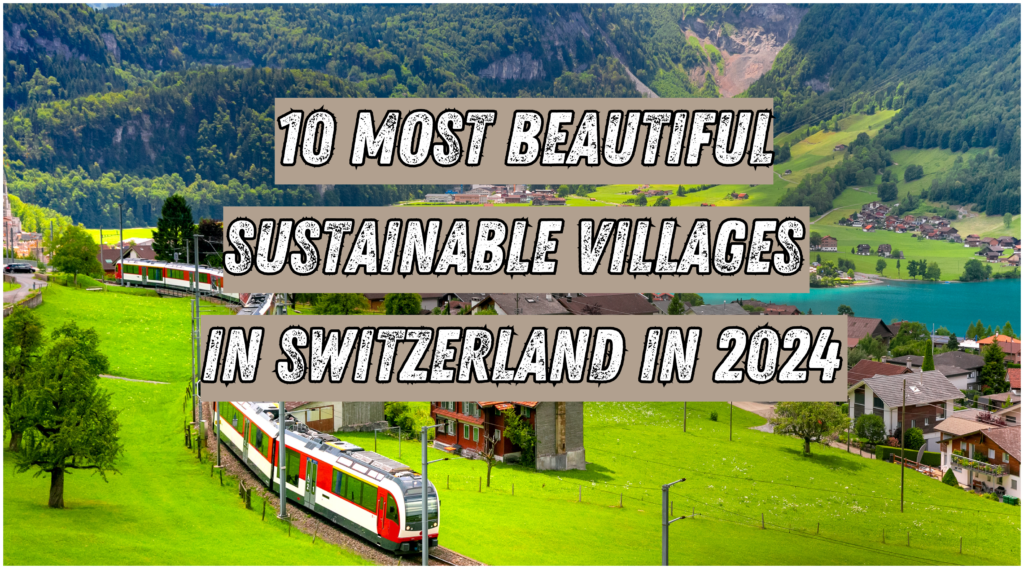Switzerland, known for its picturesque landscapes and impeccable environmental policies, boasts some of the most beautiful and sustainable villages in the world. These villages not only offer stunning views and a serene escape from city life but also prioritize sustainability, making them ideal destinations for eco-conscious travelers. In this guide, we’ll explore ten of Switzerland’s most enchanting sustainable villages, each offering a unique blend of natural beauty, cultural heritage, and environmental responsibility.
10 Most Beautiful Sustainable Villages in Switzerland in 2024
| Village | Unique Features | Sustainability Initiatives |
|---|---|---|
| Zermatt | Car-free village at the foot of the Matterhorn, accessible by electric taxis and railway. | A vibrant village in the Bernese Alps promoting eco-friendly tourism. |
| Lauterbrunnen | Zero-emission accommodations like Omnia Mountain Lodge, local food sourcing, wildlife conservation, environmental education, and Zermatt Unplugged music festival promoting eco-friendly practices. | Known for its dramatic valley and waterfalls. Generates clean energy from hydroelectric power. |
| Gimmelwald | Car-free, rustic village accessible by cable car or on foot. | Organic farming, Esther’s Guesthouse promoting sustainable living, Gimmelwald Green Project focusing on renewable energy and waste reduction, community-driven initiatives, eco-friendly hiking and biking trails. |
| Mürren | Car-free village offering views of Eiger, Mönch, and Jungfrau mountains. | Eco-friendly accommodations like Camping Jungfrau, sustainable agriculture projects, hiking trails with minimal environmental impact, and environmental regulations to preserve natural beauty. |
| Wengen | Car-free village in the Bernese Alps, accessible by train. | Public transportation and electric vehicles, sustainable accommodations like Hotel Eiger, Grindelwald Green Initiative focusing on reforestation and wildlife conservation, and extensive hiking and biking trails. |
| Grindelwald | Vibrant village in the Bernese Alps promoting eco-friendly tourism. | Public transportation and electric vehicles, sustainable accommodations like Eiger Guesthouse, Mürren Green Initiative focusing on reforestation and wildlife conservation, and extensive hiking trails with minimal environmental impact. |
| Andermatt | Modern amenities blended with sustainable practices. | Sustainable accommodations like Hotel Allalin, Saas-Fee Sustainability Initiative focusing on reforestation and environmental education, and extensive hiking and biking trails. |
| Saas-Fee | Energy-efficient accommodations like Chedi Andermatt, local food sourcing, Andermatt Sustainability Initiative focusing on reforestation and environmental education, and extensive hiking and biking trails. | Sustainable accommodations like Hotel Belvédère, local food sourcing, Wengen Sustainability Initiative promoting reforestation and environmental education, and extensive hiking and biking trails. |
| Appenzell | A car-free village known as “Pearl of the Alps,” accessible by electric taxis and railway. | Energy-efficient accommodations like Hotel Palazzo Salis, support for local businesses, Soglio Sustainability Initiative focusing on reforestation and environmental education, and extensive hiking and biking trails. |
| Soglio | Sustainable accommodations like Hotel Appenzell, support for local businesses, Appenzell Sustainability Initiative focusing on reforestation and environmental education, and extensive hiking and biking trails. | Known for its cultural heritage and stunning landscapes. |
1. Zermatt: The Car-Free Jewel

Nestled at the foot of the iconic Matterhorn, Zermatt is a shining example of sustainable tourism. This car-free village is accessible only by electric taxis or the Matterhorn Gotthard Bahn railway, significantly reducing its carbon footprint. Visitors can explore the charming streets, lined with traditional wooden chalets, and enjoy a plethora of outdoor activities, from skiing and hiking to mountain biking.
Zermatt’s commitment to sustainability extends to its accommodation options, with many hotels and lodges implementing green practices such as energy-efficient heating systems, waste reduction programs, and locally sourced food. For instance, the innovative Omnia Mountain Lodge operates on a zero-emission basis, utilizing renewable energy sources and offering organic, locally sourced cuisine.
Moreover, Zermatt actively promotes wildlife conservation and environmental education. The Zermatt Alpin Center offers guided tours that educate visitors on the importance of preserving the natural landscape and its inhabitants. which emphasizes eco-friendly practices
2. Lauterbrunnen: A Valley of Waterfalls and Green Initiatives

Lauterbrunnen, known for its dramatic valley flanked by towering cliffs and dotted with cascading waterfalls, is a paradise for nature lovers. The village is a model of sustainability, leveraging hydroelectric power from its numerous waterfalls to generate clean energy for the community.
Visitors to Lauterbrunnen can indulge in the scenic beauty while staying at eco-friendly accommodations like the Camping Jungfrau, which employs waste recycling, energy-efficient lighting, and eco-friendly materials in its construction. The campsite also offers guests the opportunity to participate in local environmental conservation projects, fostering a sense of community and responsibility.
The village’s Sustainable Agriculture Project encourages local farmers to adopt organic farming practices, reducing the use of harmful pesticides and promoting biodiversity. Guests can visit these farms to learn about sustainable farming techniques and even participate in harvesting seasonal produce.
Hiking trails in and around Lauterbrunnen are meticulously maintained to minimize environmental impact, and the local government has implemented strict regulations to preserve the pristine natural environment. The village’s dedication to sustainability ensures that its breathtaking landscapes remain unspoiled for future generations to enjoy.
3. Gimmelwald: A Rustic Haven of Eco-Friendly Living

Gimmelwald, a quaint, car-free village perched on a cliff above Lauterbrunnen, is a testament to sustainable living. Accessible only by cable car or on foot, Gimmelwald’s commitment to preserving its natural beauty and traditional way of life is evident in every aspect of the village.
The residents of Gimmelwald prioritize sustainable agriculture, with many families engaging in organic farming and raising livestock in an eco-friendly manner. Visitors can stay at family-run guesthouses like Esther’s Guesthouse, where they can enjoy farm-fresh meals and learn about sustainable living practices firsthand.
Gimmelwald also places a strong emphasis on community-driven initiatives, such as the Gimmelwald Green Project, which promotes renewable energy, waste reduction, and environmental education. The project encourages both locals and visitors to engage in sustainable practices, ensuring the village remains a pristine haven for future generations.
Outdoor enthusiasts can explore the numerous hiking and biking trails that offer stunning views of the surrounding mountains and valleys. The village’s sustainable tourism initiatives ensure that these trails are maintained without causing harm to the environment, allowing visitors to connect with nature responsibly.
4. Mürren: Alpine Charm with a Green Heart

Mürren, another car-free gem in the Bernese Oberland, is a picturesque village that exemplifies sustainable tourism. Perched on a high plateau, Mürren offers breathtaking views of the Eiger, Mönch, and Jungfrau mountains, making it a popular destination for hikers and skiers alike.
The village is committed to reducing its environmental impact through various initiatives, such as promoting the use of public transportation and electric vehicles. Mürren’s accommodation options, like the Eiger Guesthouse, prioritize sustainability by implementing energy-efficient systems, waste reduction programs, and sourcing local and organic food.
Mürren’s dedication to sustainability is also evident in its community projects, such as the Mürren Green Initiative, which focuses on preserving the natural environment through reforestation efforts and wildlife conservation programs. Visitors can participate in these initiatives, gaining a deeper understanding of the importance of environmental stewardship.
The village’s extensive network of hiking trails is designed to minimize environmental impact while providing visitors with an immersive experience in the stunning alpine landscape. Mürren’s commitment to sustainability ensures that its natural beauty is preserved for future generations to enjoy.
5. Wengen: Eco-Friendly Elegance in the Alps

Wengen, a car-free village located in the heart of the Bernese Alps, is renowned for its stunning scenery and commitment to sustainability. The village is accessible only by train, reducing traffic and pollution, and promoting a tranquil, eco-friendly atmosphere.
Wengen’s accommodation options, such as the Hotel Belvédère, prioritize sustainability through energy-efficient systems, waste reduction programs, and the use of locally sourced and organic food. The village also supports local artisans and businesses, promoting a sustainable economy that benefits the entire community.
The Wengen Sustainability Initiative focuses on preserving the natural environment through various projects, such as reforestation efforts, wildlife conservation, and environmental education programs. Visitors can participate in these initiatives, gaining a deeper understanding of the importance of protecting the environment.
Wengen’s extensive network of hiking and biking trails allows visitors to explore the breathtaking alpine landscape while minimizing their environmental impact. The village’s commitment to sustainability ensures that its natural beauty is preserved for future generations to enjoy.
6. Grindelwald: A Gateway to Sustainable Adventures

Grindelwald, nestled in the Bernese Alps, is a vibrant village known for its stunning landscapes and commitment to sustainability. The village promotes eco-friendly tourism through various initiatives, such as promoting the use of public transportation and electric vehicles and supporting local businesses that prioritize sustainability.
Grindelwald’s accommodation options, like the Hotel Eiger, prioritize sustainability by implementing energy-efficient systems, waste reduction programs, and sourcing local and organic food. The village also supports local artisans and businesses, promoting a sustainable economy that benefits the entire community.
The Grindelwald Green Initiative focuses on preserving the natural environment through various projects, such as reforestation efforts, wildlife conservation, and environmental education programs. Visitors can participate in these initiatives, gaining a deeper understanding of the importance of protecting the environment.
Grindelwald’s extensive network of hiking and biking trails allows visitors to explore the breathtaking alpine landscape while minimizing their environmental impact. The village’s commitment to sustainability ensures that its natural beauty is preserved for future generations to enjoy.
7. Andermatt: A Model of Modern Sustainability

Andermatt, located in the Ursern Valley, is a village that seamlessly blends modern amenities with sustainable practices. The village has undergone a significant transformation in recent years, with a strong focus on eco-friendly tourism and sustainable development.
Andermatt’s accommodation options, such as the Chedi Andermatt, prioritize sustainability through energy-efficient systems, waste reduction programs, and the use of locally sourced and organic food. The village also supports local artisans and businesses, promoting a sustainable economy that benefits the entire community.
The Andermatt Sustainability Initiative focuses on preserving the natural environment through various projects, such as reforestation efforts, wildlife conservation, and environmental education programs. Visitors can participate in these initiatives, gaining a deeper understanding of the importance of protecting the environment.
Andermatt’s extensive network of hiking and biking trails allows visitors to explore the breathtaking alpine landscape while minimizing their environmental impact. The village’s commitment to sustainability ensures that its natural beauty is preserved for future generations to enjoy.
8. Saas-Fee: A Glacier Village Committed to Green Tourism

Saas-Fee, known as the “Pearl of the Alps,” is a car-free village that boasts stunning glacier views and a strong commitment to sustainability. The village is accessible only by electric taxis or the Saas Valley railway, significantly reducing its carbon footprint.
Saas-Fee’s accommodation options, such as the Hotel Allalin, prioritize sustainability by implementing energy-efficient systems, waste reduction programs, and sourcing local and organic food. The village also supports local artisans and businesses, promoting a sustainable economy that benefits the entire community.
The Saas-Fee Sustainability Initiative focuses on preserving the natural environment through various projects, such as reforestation efforts, wildlife conservation, and environmental education programs. Visitors can participate in these initiatives, gaining a deeper understanding of the importance of protecting the environment.
Saas-Fee’s extensive network of hiking and biking trails allows visitors to explore the breathtaking alpine landscape while minimizing their environmental impact. The village’s commitment to sustainability ensures that its natural beauty is preserved for future generations to enjoy.
9. Appenzell: Tradition Meets Sustainability

Appenzell, a charming village known for its rich cultural heritage and stunning landscapes, is also a leader in sustainable tourism. The village promotes eco-friendly practices through various initiatives, such as supporting local businesses that prioritize sustainability and promoting the use of public transportation.
Appenzell’s accommodation options, such as the Hotel Appenzell, prioritize sustainability by implementing energy-efficient systems, waste reduction programs, and sourcing local and organic food. The village also supports local artisans and businesses, promoting a sustainable economy that benefits the entire community.
The Appenzell Sustainability Initiative focuses on preserving the natural environment through various projects, such as reforestation efforts, wildlife conservation, and environmental education programs. Visitors can participate in these initiatives, gaining a deeper understanding of the importance of protecting the environment.
Appenzell’s extensive network of hiking and biking trails allows visitors to explore the breathtaking alpine landscape while minimizing their environmental impact. The village’s commitment to sustainability ensures that its natural beauty is preserved for future generations to enjoy.
10. Soglio: A Tranquil Retreat Embracing Eco-Friendly Practices

Soglio, a picturesque village in the Bregaglia Valley, offers a tranquil retreat for those seeking to connect with nature in a sustainable way. The village prioritizes eco-friendly practices through various initiatives, such as supporting local businesses that prioritize sustainability and promoting the use of public transportation.
Soglio’s accommodation options, such as the Hotel Palazzo Salis, prioritize sustainability by implementing energy-efficient systems, waste reduction programs, and sourcing local and organic food. The village also supports local artisans and businesses, promoting a sustainable economy that benefits the entire community.
The Soglio Sustainability Initiative focuses on preserving the natural environment through various projects, such as reforestation efforts, wildlife conservation, and environmental education programs. Visitors can participate in these initiatives, gaining a deeper understanding of the importance of protecting the environment.
Soglio’s extensive network of hiking and biking trails allows visitors to explore the breathtaking alpine landscape while minimizing their environmental impact. The village’s commitment to sustainability ensures that its natural beauty is preserved for future generations to enjoy.
Conclusion
Switzerland’s commitment to sustainability is evident in its picturesque villages, where eco-friendly practices are seamlessly integrated into daily life. From car-free havens to communities powered by renewable energy, these villages offer a glimpse into a future where tourism and environmental responsibility go hand in hand. By choosing to visit these sustainable destinations, travelers can enjoy the breathtaking beauty of Switzerland while contributing to the preservation of its natural landscapes.
FAQs
Q: What makes a village sustainable?
A: A sustainable village prioritizes eco-friendly practices such as renewable energy, waste reduction, and supporting local businesses. It also promotes environmental conservation and education, ensuring that the natural landscape remains unspoiled for future generations.
Q: How can I travel sustainably in Switzerland?
A: To travel sustainably in Switzerland, use public transportation, stay in eco-friendly accommodations, and support local businesses. Participate in community-driven initiatives and follow guidelines to minimize your environmental impact.
Q: Are there any eco-friendly activities to do in these villages?
A: Yes, these villages offer a range of eco-friendly activities such as hiking, biking, and wildlife tours. Many also have initiatives where visitors can participate in environmental conservation projects and learn about sustainable living practices.



